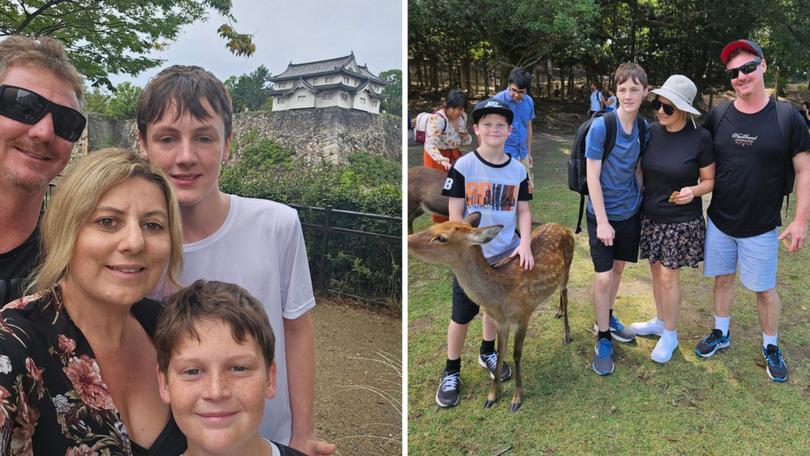Why Japan is proving a strong rival to Bali and Indonesia for travel-hungry Australians

Indonesia — including Bali— has retained its title as Australia’s most popular holiday hotspot — but another country famed for its culinary options, stunning natural wonders and big city adventures is proving just the antidote for a growing number of people bitten by the travel bug.
Close to 730,000 Australians visited Japan in the 12 months to August, double the number from 12 months prior, according to a new report by the Australian Travel Industry Association (ATIA).
Travel figures show Australians are throwing themselves at international opportunities that were closed off during COVID-19 border restrictions, and the association says our growing love affair with the East Asian country is a sign we are hungry for new destinations and experiences.
“The incredible 30.4 per cent year-on-year rise in travel to Indonesia, our top overseas destination, shows how much demand for international travel has skyrocketed,” ATIA chief executive Dean Long said.
ROAM. Landing in your inbox weekly.
A digital-first travel magazine. Premium itineraries and adventures, practical information and exclusive offers for the discerning traveller.
By continuing you agree to our Terms and Privacy Policy.“But it’s the growth in new and emerging markets that really tell the story of 2024.
“The 103.4 per cent surge in travel to Japan is a clear sign that Australians are looking for more than just a getaway — they’re seeking cultural immersion and unique experiences.”
Long said there has been a shift towards “more adventurous and diversified travel”, with Thailand and Vietnam growing by 20.2 per cent and 40.1 per cent, respectively.
Japan is a “country of contrast”, mixing longstanding tradition and modernity, ANU Australia-Japan Research Centre director Shiro Armstrong told 7NEWS.com.au.
He said the country’s weak yen and 25 years of deflation made it affordable for families juggling soaring costs back home.
And a combination of other factors — safety, cleanliness, a smooth-running public transport system, food options, big cities and smaller, older towns — means Australians are increasingly comfortable exploring a country that is “very different culturally”.
“Many Australians were choosing Japan for its skiing and snowboarding seasons, but now it’s all year round with more flights being put on,” he said.
“You hear stories that flights are being filled quickly.”


Perth mother Melissa Anderson travelled to Japan earlier this month with husband Nathan and her two sons.
Originally planning a holiday to Hawaii, she was swayed into visiting the Land of the Rising Sun by “how much there was for us to do as a family” and the chance for her boys to experience a different culture.
Anderson said Riley, aged 13, and Brandon, 11, were inspired to try things they would not usually do and soaked up countless new experiences.
They stayed in Osaka and Tokyo over two weeks, checking out theme parks, arcades, local restaurants and architecture and famous landmarks including Osaka Castle, Bamboo Forest and Nara Park.
They rode a bullet train and attended Shinagawa Aquarium, Tokyo Sky Tree, Disneyland and much more — saying they barely scratched the surface.
Anderson said the country had an undeniable wow-factor.
“Everything is inspiring, everything is decorative and on show, Every part of the city is like a theme park in the street,” she said.
Importantly while overseas, she said she felt “safe” and “that my kids were safe”.

The ATIA report reinforced the popularity of perennial favourite tourist destinations New Zealand and the US, which recorded travel growth rates of 10 per cent and 16.7 per cent respectively.
“Australians have a renewed confidence in international travel, and they’re eager to explore both near and far-flung destinations,” Long said.
“Whether it’s the lure of vibrant cities, natural landscapes or cultural attractions, Australians are travelling more frequently and to a wider range of destinations than we’ve seen in recent years.
“This strong momentum in outbound travel reflects a significant mindset shift compared to this time last year.”
Those comments are supported by figures from the Australian Bureau of Statistics showing Australians left our shores on 1.69 million occasions in August compared with the 1.52 million overseas trips 12 months prior.
In August 2022, less than one million people left our shores and the figures were basically rock bottom during COVID border restrictions in 2020 and 2021.
Long said the travel momentum — which includes growth in business travel and visits to friends and family — was not a short-term rebound.
“It’s a long-term trend that shows Australians are eager to make up for lost time,” he said.
Originally published on 7NEWS
